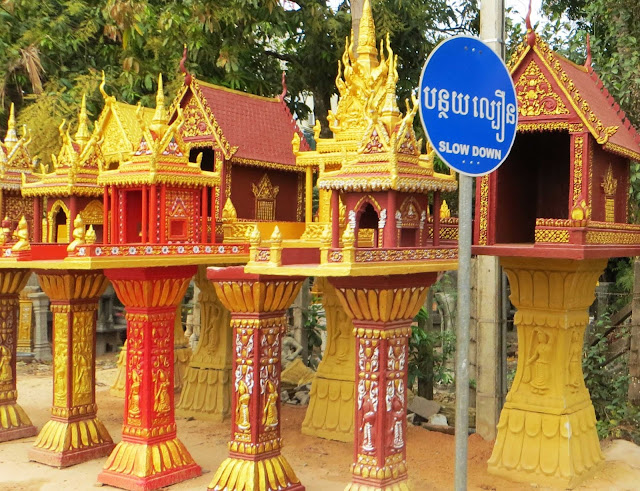Volunteers Donna and Jill and I have had dinner
together several times now and did so again Friday night, at the Red Piano,
made famous by the patronage of Tomb
Raider Angelina Jolie. Jill mentioned that she had a tuktuk booked to take
her to Beng Mealea the next day and asked if we wanted to go along.
I’d been
before but agreed immediately to go again. I haven’t been doing much with my
weekends recently so the chance of a long tuktuk ride out of the city and of
flexing my IndiAnnie instincts clambering about amongst ancient ruins was impossible to
resist. Donna hesitated as she was feeling weary after a long hot week at the
volunteering coalface and, in the event, decided more sleep was preferable.
Not me! I set my alarm for 6am and got an early
night, excited at the prospect of an excellent day out. Soon after 8 the next
morning, I was at Jill’s hotel and we set off with Mr Ong, her favourite tuktuk
driver, at about 8.20. Riding down national route 6 is always interesting, if a
trifle scary with all the crazy drivers weaving madly in and out but Mr Ong
proved capable and cautious, and saw us safely there and back for the very
reasonable sum of US$35.
The road to Beng Mealea takes you down route 6
about 25kms to the town of Damdek,
where you turn left and head out into the countryside through, at this time of
the year, the bone-dry stubble of rice fields and an assortment of small
settlements. The hot wind blasted my hair into the most unflattering of styles;
I smiled and waved at small children playing by the wayside and women sitting
gossiping outside their wooden shacks; I savoured the ubiquitous smell of wood
smoke and used my ever-present krama
to avoid choking on the equally ubiquitous red dust; and I snapped photos of
locals perched precariously atop trailer-loads of wood or squashed four to a
motorbike, plus shopping. These are some of my favourite things about Cambodia!
small.jpg)
The entrance fee to Beng Mealea is just US$5,
unrivalled value for the three hours we spent exploring. Most tourists probably
take just half that time, but Jill turned out to be a like-minded soul, a
Classics scholar like me, fascinated with ancient architecture and keen to
explore every nook and cranny.
The name Beng Mealea means ‘lotus pond’ but the
only flowers I saw in the 45-metre-wide moat that surrounds the site were water
hyacinths. The tourist approach is across this moat from the south, along a
causeway bordered by long balustrades representing the bodies of the
seven-headed nagas that guard the causeway entrance. The south gate itself is
blocked by fallen masonry, but authorities have constructed a series of wooden
steps and walkways that carry the visitor into this masonry maze, up and over
stone walls and cloisters to the rooftops and first floor levels so you can get
an excellent idea of the layout of the temple complex.
small.jpg) |
| One of the nagas, with the south gate in the background |
small.jpg) |
| Looking back out through the south gate from inside the complex |
It is large – approximately one kilometre square
– and has been greatly ravaged by weather erosion and rampant vegetation, with
tree roots and strangler vines prising apart the massive stones, causing them
to tumble into large mounds like some giant’s abandoned Lego. Nothing has been
restored so you can get a good feel for what all the Angkorian temples would
have looked like when first reclaimed from the jungle.
Little is known of Beng Mealea’s history or why
it was built at such a distance from the main Angkor
temples near Siem Reap, but its architectural similarities with Angkor Wat have
led archaeologists to surmise that it was built by King Suryavaram in the early
12th century. Although it was primarily a Hindu temple, it also has some
Buddhist carvings amongst its ruins. Few of the sculptural reliefs are in good
condition but it is possible to make out scenes from the Hindu myth of the
Churning of the Sea
of Milk, apsara dancers
can be spotted amongst the confusion of stones, and a lion’s feet sit alone, forever
disconnected from their owner.
small.jpg)
small.jpg)
At approximately 75kms distance by road, Beng
Mealea is far enough from Siem Reap to be spared the hordes of tourists that can
nowadays spoil the Angkor Wat tourist experience, though the busloads have begun
to invade here too. Luckily, it is still possible to find a quiet spot to
marvel at the wonderful variety of butterflies fluttering around the stones, to
linger while small lizards do battle over their territory, and to try to
imagine what this enigmatic place was like in its heyday.
One word of caution … don’t wander off the
well-trodden paths here. A sign near the entrance declares that 438 anti-personnel
mines and 809 UXOs (pieces of unexploded ordinance) have been cleared from the
area in the past 10 years but the work is ongoing!
small.jpg)
small.jpg)
small.jpg)

small.jpg)
small.jpg)
small.jpg)
small.jpg)
small.jpg)
small.jpg)
small.jpg)

small.jpg)
small.jpg)
small.jpg)
small.jpg)

small.jpg)
small.jpg)
small.jpg)
small.jpg)
small.jpg)
small.jpg)
small.jpg)
small.jpg)
small.jpg)
small.jpg)
small.jpg)
small.jpg)
small.jpg)
small.jpg)
.JPG)